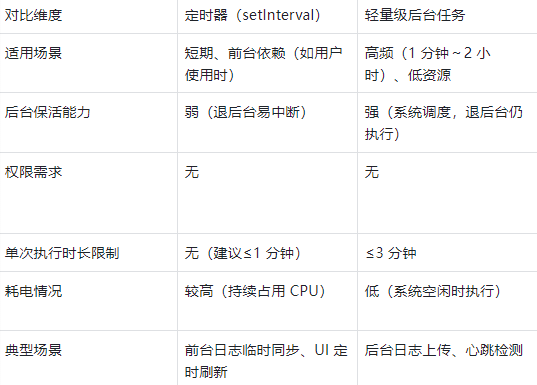鸿蒙后台定时任务实战
在鸿蒙(HarmonyOS)应用开发中,后台定时任务是常见需求 —— 如日志定期上传、数据增量同步、心跳检测等。但鸿蒙系统对后台进程有严格的资源管控,若仅用传统定时器实现,易出现 “应用退后台后任务中断”“耗电过高被系统限制” 等问题。这里我将系统讲解鸿蒙中两种核心的后台定时方案:定时器(短期轻量场景) 与 系统级后台任务调度(长期稳定场景),并结合日志上传案例,给出完整实现代码与选型建议,帮你避开常见坑点。希望对大家有所帮助
一、先明确核心问题:为什么不能只依赖定时器?
在讨论方案前,需先理解鸿蒙的后台资源管控逻辑 —— 为平衡 “功能需求” 与 “设备续航”,鸿蒙对后台进程的资源分配有明确限制:
应用退至后台后(如用户按 Home 键),系统会逐步回收 CPU、内存资源,定时器(如setInterval)可能在 3-5 分钟内被暂停;
若用户通过 “最近任务列表” 关闭应用,进程直接销毁,定时器任务完全终止;
高频定时器(如 1 分钟 / 次)会持续占用 CPU,导致耗电过快,触发系统的 “后台耗电管控”,强制终止任务。
这意味着:
若任务仅需 “用户前台使用时执行”(如用户打开应用期间,每 10 分钟上传一次操作日志),定时器可满足需求;
若需 “应用退后台甚至进程销毁后仍稳定执行”(如每天凌晨 2 点上传全天日志),必须依赖鸿蒙原生的后台任务调度能力—— 由系统统一管控任务触发时机,即使应用进程被回收,系统也会在资源空闲时唤醒任务。
二、方案一:定时器(短期轻量,快速落地)
定时器适合短期、前台依赖的定时任务,实现简单,无需申请额外权限,适合调试阶段或临时需求(如用户使用期间的日志临时同步)。鸿蒙中可通过 ArkTS 的setInterval或 Java 的Timer实现,核心是 “在应用生命周期中管理定时器生命周期”,避免内存泄漏与无效耗电。
1. ArkTS 实现:日志上传案例
以 “用户前台使用时,每 10 分钟上传一次操作日志” 为例,需在页面显示时启动定时器,页面隐藏时销毁定时器,确保资源不浪费。
import hilog from '@ohos.hilog';
import { BusinessError } from '@ohos.base';
import fs from '@ohos.file.fs';
import http from '@ohos.net.http';@Entry
@Component
struct LogUploadPage {// 定时器ID:用于后续取消任务,避免重复创建private intervalId: number | null = null;// 同步间隔:10分钟(单位:毫秒),根据需求调整private readonly SYNC_INTERVAL = 10 * 60 * 1000;// 日志存储路径:应用沙箱的缓存目录(确保数据安全)private readonly LOG_PATH = `${getContext().cacheDir}/app_operation_logs.txt`;build() {Column({ space: 20 }) {Text('应用操作日志同步中').fontSize(18).fontWeight(FontWeight.Medium)Text(`当前同步间隔:${this.SYNC_INTERVAL / 60000}分钟`).fontSize(14).textColor('#666666')}.width('100%').height('100%').justifyContent(FlexAlign.Center)}// 页面显示时启动定时器(前台场景触发)onPageShow() {hilog.info(0x0000, 'LogSync', '页面显示,启动日志同步定时器');this.startLogSyncTimer();}// 页面隐藏时取消定时器(避免后台无效耗电)onPageHide() {hilog.info(0x0000, 'LogSync', '页面隐藏,取消日志同步定时器');this.stopLogSyncTimer();}// 应用销毁时彻底取消定时器(防止内存泄漏)aboutToDisappear() {this.stopLogSyncTimer();}/*** 启动定时同步任务*/private startLogSyncTimer() {// 避免重复创建定时器(如页面反复切换导致多个任务同时运行)if (this.intervalId !== null) return;this.intervalId = setInterval(async () => {try {hilog.info(0x0000, 'LogSync', '开始执行定时日志上传');// 1. 读取本地日志文件const logContent = await this.readLocalLogs();if (!logContent) {hilog.info(0x0000, 'LogSync', '本地无新增日志,跳过上传');return;}// 2. 调用后端接口上传日志await this.uploadLogsToServer(logContent);// 3. 上传成功后清空本地日志(避免重复上传)await this.clearLocalLogs();hilog.info(0x0000, 'LogSync', '日志上传成功,已清空本地缓存');} catch (error) {const err = error as BusinessError;hilog.error(0x0000, 'LogSync', `日志上传失败:${err.code} - ${err.message}`);}}, this.SYNC_INTERVAL);}/*** 停止定时任务*/private stopLogSyncTimer() {if (this.intervalId !== null) {clearInterval(this.intervalId);this.intervalId = null;}}/*** 读取本地日志文件*/private async readLocalLogs(): Promise<string> {try {// 检查日志文件是否存在const fileExists = await fs.access(this.LOG_PATH);if (!fileExists) return '';// 读取文件内容(UTF-8编码)const file = await fs.open(this.LOG_PATH, fs.OpenMode.READ_ONLY);const buffer = await fs.read(file.fd, { offset: 0, length: 1024 * 1024 }); // 最大读取1MBawait fs.close(file.fd);return Buffer.from(buffer.buffer).toString('utf-8');} catch (error) {hilog.error(0x0000, 'LogSync', `读取本地日志失败:${(error as BusinessError).message}`);return '';}}/*** 上传日志到服务器*/private async uploadLogsToServer(logContent: string): Promise<void> {const httpRequest = http.createHttp();try {const response = await httpRequest.request('https://your-server.com/api/log/upload', // 替换为实际接口地址{method: http.RequestMethod.POST,header: {'Content-Type': 'application/json'},extraData: JSON.stringify({appVersion: getContext().applicationInfo.versionName, // 应用版本deviceModel: deviceInfo.deviceModel, // 设备型号logContent: logContent})});if (response.responseCode !== 200) {throw new Error(`服务器返回异常:${response.responseCode}`);}} finally {// 无论成功失败,都关闭HTTP请求(避免资源泄漏)httpRequest.destroy();}}/*** 清空本地日志文件*/private async clearLocalLogs() {try {const file = await fs.open(this.LOG_PATH, fs.OpenMode.WRITE_ONLY | fs.OpenMode.TRUNCATE);await fs.close(file.fd);} catch (error) {hilog.error(0x0000, 'LogSync', `清空本地日志失败:${(error as BusinessError).message}`);}}
}
2. 定时器方案的关键注意事项
生命周期绑定:必须在onPageHide、aboutToDisappear中取消定时器,否则页面切换后会残留任务,导致重复上传或耗电;
任务幂等性:日志上传需保证 “重复执行不产生脏数据”(如上传成功后清空本地日志,避免下次重复上传);
资源限制:单次任务执行时间不宜过长(建议≤1 分钟),避免阻塞 UI 线程(若需处理大文件,可拆分为多批次)。
三、方案二:系统级后台任务调度(长期稳定,推荐)
若需 “应用退后台、进程销毁甚至设备重启后仍稳定执行任务”(如每天凌晨 2 点上传全天日志、每 1 小时同步一次数据),需使用鸿蒙原生的后台任务调度能力。鸿蒙提供两种核心类型:轻量级后台任务(高频低资源)与延迟后台任务(低频高资源),由系统统一调度,平衡 “任务稳定性” 与 “设备续航”。
1. 轻量级后台任务(高频低资源,日志上传首选)
适合1 分钟~2 小时间隔、单次执行时间≤3 分钟、资源消耗低的任务(如日志上传、心跳检测)。无需申请特殊权限,系统会在 CPU 空闲、电量充足时触发任务,即使应用退后台也能稳定执行。
实现步骤:全局单例管理(AbilityStage 中初始化)
轻量级任务需全局管理,避免重复创建,建议在AbilityStage(应用全局生命周期组件)中初始化,确保应用启动时任务自动启动,销毁时任务停止。
import hilog from '@ohos.hilog';
import backgroundTaskManager from '@ohos.backgroundTaskManager';
import { BusinessError } from '@ohos.base';
import fs from '@ohos.file.fs';
import http from '@ohos.net.http';
import deviceInfo from '@ohos.deviceInfo';// 日志同步管理器:单例模式,避免重复创建任务
class LogSyncManager {private static instance: LogSyncManager;// 轻量级任务ID:用于取消任务private lightTaskId: number | null = null;// 同步间隔:1小时(单位:秒),支持1分钟~2小时private readonly SYNC_INTERVAL = 3600;// 日志存储路径:应用沙箱目录private readonly LOG_PATH = `${getContext().cacheDir}/app_operation_logs.txt`;// 单例模式:确保全局唯一实例public static getInstance(): LogSyncManager {if (!this.instance) {this.instance = new LogSyncManager();}return this.instance;}/*** 启动轻量级后台任务*/public startLightweightSync() {try {// 避免重复创建任务if (this.lightTaskId !== null) {hilog.info(0x0000, 'LogSync', '轻量级任务已启动,无需重复创建');return;}// 注册轻量级任务:参数1为任务回调,参数2为间隔(秒)this.lightTaskId = backgroundTaskManager.startLightweightTask(async (taskId: number) => {hilog.info(0x0000, 'LogSync', `轻量级任务触发,ID:${taskId}`);try {// 执行日志上传逻辑const logContent = await this.readLocalLogs();if (logContent) {await this.uploadLogsToServer(logContent);await this.clearLocalLogs();hilog.info(0x0000, 'LogSync', '轻量级任务:日志上传成功');} else {hilog.info(0x0000, 'LogSync', '轻量级任务:无新增日志');}} catch (error) {const err = error as BusinessError;hilog.error(0x0000, 'LogSync', `轻量级任务执行失败:${err.code} - ${err.message}`);} finally {// 任务执行完成后,重新注册下一次任务(循环调度)this.scheduleNextTask();}},this.SYNC_INTERVAL);hilog.info(0x0000, 'LogSync', `轻量级任务启动成功,ID:${this.lightTaskId}`);} catch (error) {const err = error as BusinessError;hilog.error(0x0000, 'LogSync', `启动轻量级任务失败:${err.code} - ${err.message}`);}}/*** 停止轻量级后台任务*/public stopLightweightSync() {if (this.lightTaskId !== null) {backgroundTaskManager.stopLightweightTask(this.lightTaskId);this.lightTaskId = null;hilog.info(0x0000, 'LogSync', '轻量级任务已停止');}}/*** 调度下一次任务(确保循环执行)*/private scheduleNextTask() {// 先停止当前任务,避免重复this.stopLightweightSync();// 延迟1秒后重新启动(避免立即创建导致系统限制)setTimeout(() => {this.startLightweightSync();}, 1000);}// 读取本地日志(同方案一,省略重复代码)private async readLocalLogs(): Promise<string> { /* 实现同上 */ }// 上传日志到服务器(同方案一,省略重复代码)private async uploadLogsToServer(logContent: string): Promise<void> { /* 实现同上 */ }// 清空本地日志(同方案一,省略重复代码)private async clearLocalLogs() { /* 实现同上 */ }
}// 应用全局生命周期组件:AbilityStage
export default class MyAbilityStage extends AbilityStage {private logSyncManager: LogSyncManager = LogSyncManager.getInstance();// 应用启动时启动后台任务onCreate() {super.onCreate();hilog.info(0x0000, 'LogSync', '应用启动,初始化后台日志同步');this.logSyncManager.startLightweightSync();}// 应用销毁时停止后台任务onDestroy() {super.onDestroy();hilog.info(0x0000, 'LogSync', '应用销毁,停止后台日志同步');this.logSyncManager.stopLightweightSync();}
}
2. 延迟后台任务(低频高资源,大文件同步)
适合2 小时以上间隔、单次执行时间≤10 分钟、资源消耗较高的任务(如大日志文件上传、全量数据同步)。需申请ohos.permission.KEEP_BACKGROUND_RUNNING权限,支持 “设备重启后任务继续执行”,稳定性更强。
实现步骤:权限配置 + 任务调度
配置权限:在main_pages.json(或config.json)中添加后台权限,说明权限用途(用户可见):
{"module": {"package": "com.example.logsync","abilities": [{"name": ".MainAbility","label": "日志同步应用","permissions": [{"name": "ohos.permission.KEEP_BACKGROUND_RUNNING","reason": "需要在后台长期上传日志文件","usedScene": {"ability": [".MainAbility"],"when": "always"}}]}]}
}
代码实现(延迟任务调度):
import hilog from '@ohos.hilog';
import backgroundTaskManager from '@ohos.backgroundTaskManager';
import { BusinessError } from '@ohos.base';class DelayedLogSyncManager {// 延迟任务请求参数private taskRequest: backgroundTaskManager.DelayedTaskRequest = {delayTime: 86400, // 延迟执行时间:24小时(单位:秒),即每天执行一次isPersisted: true, // 设备重启后是否继续执行(true=继续)callback: async () => {hilog.info(0x0000, 'LogSync', '延迟后台任务触发:开始上传全天日志');try {// 执行大日志上传逻辑(如读取全天日志文件,分批次上传)await this.uploadDailyLogs();hilog.info(0x0000, 'LogSync', '延迟任务:全天日志上传成功');} catch (error) {hilog.error(0x0000, 'LogSync', `延迟任务执行失败:${(error as BusinessError).message}`);} finally {// 重新调度下一次任务(每天执行)this.scheduleDelayedTask();}}};/*** 调度延迟后台任务*/public scheduleDelayedTask() {try {backgroundTaskManager.startDelayedTask(this.taskRequest,(err: BusinessError) => {if (err) {hilog.error(0x0000, 'LogSync', `调度延迟任务失败:${err.code} - ${err.message}`);return;}hilog.info(0x0000, 'LogSync', '延迟任务调度成功,将在24小时后执行');});} catch (error) {const err = error as BusinessError;hilog.error(0x0000, 'LogSync', `启动延迟任务失败:${err.code} - ${err.message}`);}}/*** 取消延迟后台任务*/public cancelDelayedTask() {backgroundTaskManager.cancelDelayedTask(this.taskRequest,(err: BusinessError) => {if (err) {hilog.error(0x0000, 'LogSync', `取消延迟任务失败:${err.code} - ${err.message}`);return;}hilog.info(0x0000, 'LogSync', '延迟任务已取消');});}/*** 上传全天日志(大文件处理)*/private async uploadDailyLogs() {// 1. 读取全天日志文件(可能体积较大,需分片处理)const logPath = `${getContext().cacheDir}/daily_logs_${new Date().toLocaleDateString()}.txt`;const file = await fs.open(logPath, fs.OpenMode.READ_ONLY);const fileSize = (await fs.stat(logPath)).size;// 2. 分片上传(每片100KB,避免单次请求过大)const chunkSize = 1024 * 100;const totalChunks = Math.ceil(fileSize / chunkSize);for (let i = 0; i < totalChunks; i++) {const buffer = await fs.read(file.fd, {offset: i * chunkSize,length: Math.min(chunkSize, fileSize - i * chunkSize)});// 调用分片上传接口await this.uploadLogChunk(buffer, i, totalChunks);}await fs.close(file.fd);// 3. 上传完成后删除本地文件await fs.unlink(logPath);}/*** 分片上传日志*/private async uploadLogChunk(buffer: ArrayBuffer, chunkIndex: number, totalChunks: number) {const httpRequest = http.createHttp();try {const response = await httpRequest.request('https://your-server.com/api/log/upload-chunk',{method: http.RequestMethod.POST,header: { 'Content-Type': 'application/octet-stream' },extraData: buffer,params: {chunkIndex: chunkIndex,totalChunks: totalChunks,fileName: `daily_log_${new Date().toLocaleDateString()}.txt`}});if (response.responseCode !== 200) {throw new Error(`分片${chunkIndex}上传失败:${response.responseCode}`);}} finally {httpRequest.destroy();}}
}// 在AbilityStage中使用
export default class MyAbilityStage extends AbilityStage {private delayedLogSyncManager: DelayedLogSyncManager = new DelayedLogSyncManager();onCreate() {super.onCreate();// 申请后台权限(需用户授权)this.requestBackgroundPermission();// 调度延迟任务(每天执行一次)this.delayedLogSyncManager.scheduleDelayedTask();}onDestroy() {super.onDestroy();this.delayedLogSyncManager.cancelDelayedTask();}/*** 申请后台运行权限(用户授权)*/private async requestBackgroundPermission() {const context = this.getContext();const permission = 'ohos.permission.KEEP_BACKGROUND_RUNNING';// 检查权限是否已授权const status = await context.checkPermission(permission);if (status === 0) {hilog.info(0x0000, 'LogSync', '后台权限已授权');return;}// 申请权限(弹窗提示用户)const result = await context.requestPermissionsFromUser([permission]);if (result.grantedPermissions.includes(permission)) {hilog.info(0x0000, 'LogSync', '用户已授权后台权限');} else {hilog.warn(0x0000, 'LogSync', '用户拒绝后台权限,延迟任务可能无法正常执行');}}
}
四、两种方案对比

我们可以从下面角度来考虑如何选择
任务是否需要 “应用退后台后执行”?
否 → 选定时器;
是 → 进入下一步;
任务间隔是否≤2 小时且资源消耗低?
是 → 选轻量级后台任务;
否(间隔≥2 小时或资源高) → 选延迟后台任务。
五、避坑指南:确保后台任务稳定执行
系统资源管控适配:
低电量(≤20%)或低内存时,系统会暂停后台任务,需在任务中添加 “重试逻辑”(如上传失败后延迟 5 分钟重试);
避免在用户夜间休息时段(如 23:00-7:00)执行高频任务,系统可能会优先保障睡眠功耗。
任务幂等性设计:
日志上传需确保 “重复执行不重复上传”(如上传成功后清空本地日志,或给日志添加唯一 ID);
分片上传需支持 “断点续传”,避免因网络中断导致前功尽弃。
权限与用户体验平衡:
延迟任务需申请后台权限,需在申请时明确告知用户 “权限用途”(如 “需要在后台上传日志,不会影响设备续航”),避免用户拒绝;
可在应用设置中添加 “后台同步开关”,允许用户手动控制是否开启(提升用户信任度)。
日志与监控:
在任务关键节点添加日志(如任务触发、上传成功 / 失败),便于后续问题排查;
可对接鸿蒙的 “应用监控平台”,实时监控后台任务执行状态(如失败次数、执行时长)。
六、总结
鸿蒙后台定时任务的核心是 “根据场景选对方案”:短期前台任务用定时器快速落地,长期后台任务依赖系统调度保障稳定。无论是日志上传、数据同步还是心跳检测,只要结合 “生命周期管理”“幂等性设计” 与 “系统资源适配”,就能在 “功能稳定” 与 “设备续航” 之间找到平衡,为用户提供流畅且不打扰的应用体验。
我个人建议是实际开发中,建议优先使用 “轻量级后台任务” 处理高频后台需求(如日志上传),如需长期低频任务再考虑 “延迟后台任务”,避免过度依赖定时器导致任务不稳定。
